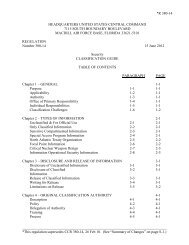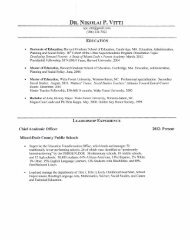extracts-studies-dec-2016
extracts-studies-dec-2016
extracts-studies-dec-2016
Create successful ePaper yourself
Turn your PDF publications into a flip-book with our unique Google optimized e-Paper software.
Product Evaluation<br />
“How good is your batting average?”<br />
Early IC Efforts To Assess the Accuracy of Estimates<br />
Jim Marchio<br />
“Few things are asked<br />
the estimator more<br />
often than ‘How good is<br />
your batting average?’<br />
No question could be<br />
more legitimate—and<br />
none could be harder<br />
to answer.”<br />
Sherman Kent was never more<br />
blunt or accurate than when he observed<br />
in his memoir-history of the<br />
Office of National Estimates (ONE):<br />
“Few things are asked the estimator<br />
more often than ‘How good is your<br />
batting average?’ No question could<br />
be more legitimate—and none could<br />
be harder to answer.” 1 This article<br />
explores one of the Intelligence Community’s<br />
(IC) earliest efforts to assess<br />
the accuracy of its estimative judgments.<br />
Led by Kent and his deputy,<br />
Abbot E. Smith, the IC systematically<br />
examined the judgments contained<br />
in more than 200 estimates between<br />
1955 and 1962, sharing its findings<br />
with IC members in a series of “validity<br />
<strong>studies</strong>.” The factors driving<br />
the effort, the challenges encountered<br />
in executing it, and the findings<br />
contained in the validity <strong>studies</strong> all<br />
are of value today as the Office of<br />
the Director of National Intelligence<br />
(ODNI) and other members of the IC<br />
attempt to answer the same question<br />
involving the accuracy of their<br />
analysis. a<br />
This IC “experiment” conducted<br />
six <strong>dec</strong>ades ago reminds us how<br />
difficult it is to determine “batting<br />
averages” as well as the importance<br />
of doing so, especially if the IC is to<br />
learn from its errors and improve its<br />
estimative accuracy.<br />
a. The author acknowledges the valuable<br />
comments of John Botzenhart on an early<br />
draft of this article.<br />
Origins of the Initiative<br />
Exploring ways to improve the<br />
quality and, in turn, the accuracy<br />
of the intelligence analysis given to<br />
US leaders began with the origins<br />
of the IC. However, the perceived<br />
intelligence failure associated with<br />
the outbreak of hostilities in Korea in<br />
1950 spurred new efforts. 2 In 1952, a<br />
production program for national intelligence<br />
estimates was initiated. This<br />
program provided “for a reexamination<br />
of existing estimates on critical<br />
areas or problems as well as the<br />
production of new estimates designed<br />
to improve the coverage of important<br />
topics.” The program continued and<br />
expanded the practice of producing<br />
“postmortems,” assessments designed<br />
“to reveal deficiencies in the<br />
preparation of selected estimates and<br />
to stimulate corrective action.” b The<br />
b. The term “postmortem” has been used in<br />
different ways in the IC’s history. Initially,<br />
it was used to denote a product that<br />
identified shortcomings in collection and<br />
analytic research on an issue on which an<br />
estimate had been completed. As Sherman<br />
Kent noted: “In the early 1950s we initiated<br />
an exercise—collateral to the main task<br />
of the ONE—which, however laudable,<br />
became a major pain in the neck. This was<br />
the ex post facto examination of important<br />
estimates with an idea of identifying the<br />
most significant gaps in our knowledge.<br />
Almost from the start it was called a “postmortem.”<br />
See “The Making of an NIE,”<br />
Sherman Kent and the Board of Estimates:<br />
Collected Essays (Center for the Study of<br />
Intelligence), 25.<br />
The views, opinions, and findings should not be construed as asserting or implying US government endorsement of its factual<br />
statements and interpretations or representing the official positions of any component of the United States government.<br />
Studies in Intelligence Vol 60, No. 4 (Extracts, December <strong>2016</strong>)<br />
3




